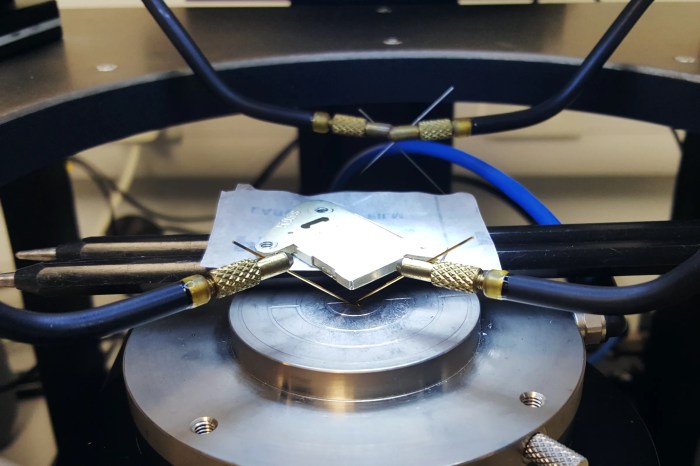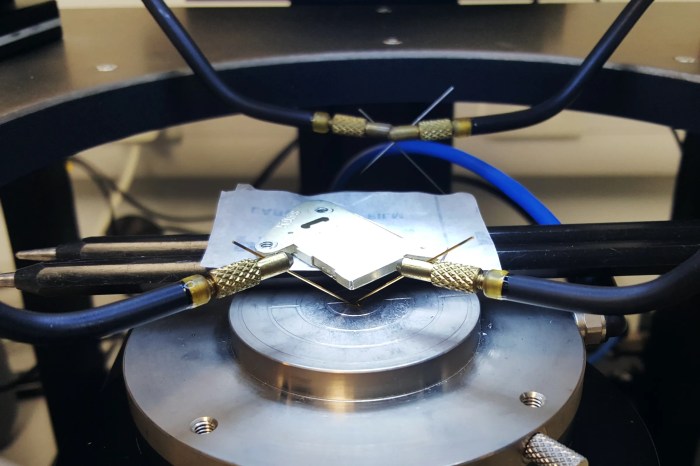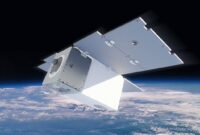European scientists developing nuclear waste batteries for use in spacecraft are pushing the boundaries of space exploration. Imagine a future where spacecraft are powered by the very waste that we once considered a burden. This isn’t science fiction; it’s a reality that scientists are working hard to make a reality.
While traditional power sources like solar panels and chemical batteries have their limitations, these nuclear waste batteries promise a game-changing solution for long-duration missions, enabling us to venture further into the cosmos than ever before.
The concept behind these batteries is surprisingly simple: harnessing the energy released from radioactive decay. This energy can be converted into electricity, providing a long-lasting and reliable power source for spacecraft. The potential applications are vast, ranging from powering deep space probes to enabling human missions to Mars and beyond.
This technology could be the key to unlocking a new era of space exploration.
Nuclear Waste Batteries for Spacecraft
The concept of nuclear waste batteries revolves around harnessing the energy released from the radioactive decay of nuclear waste. This energy can be converted into electricity, providing a long-lasting and reliable power source for various applications, particularly in spacecraft. These batteries offer a compelling alternative to traditional spacecraft power sources, which often face limitations in terms of energy density, lifespan, and reliability.
Solar panels, for instance, rely on sunlight and become less efficient as they move further away from the sun. Batteries based on chemical reactions have limited energy storage capacity and require frequent recharging. Nuclear waste batteries, however, can provide a continuous and long-lasting source of power, even in deep space environments.
The Significance of European Research
European scientists are at the forefront of developing nuclear waste batteries for spacecraft. Their research holds immense significance, as it could pave the way for longer, more ambitious space missions and the exploration of distant corners of the solar system.
By finding practical applications for nuclear waste, this research also addresses the critical challenge of safely managing and disposing of this hazardous material.
Technology Behind Nuclear Waste Batteries
Nuclear waste batteries, also known as radioisotope thermoelectric generators (RTGs), harness the energy released from the radioactive decay of nuclear waste to generate electricity. These batteries offer a unique and reliable power source for long-duration space missions, particularly in environments where solar power is limited, such as deep space exploration or missions to the outer solar system.
Scientific Principles
The fundamental principle behind nuclear waste batteries is the conversion of heat energy generated by radioactive decay into electrical energy. This process is achieved through a phenomenon known as the Seebeck effect. The Seebeck effect describes the generation of an electrical voltage across a junction of two different materials when there is a temperature difference between the two.
In nuclear waste batteries, a radioactive material, typically a long-lived isotope like plutonium-238, is encased in a thermoelectric generator. The radioactive decay of this material produces heat, creating a temperature gradient across the thermoelectric junctions. This temperature difference drives the flow of electrons, generating a direct current (DC) electricity.
Conversion of Nuclear Waste into Energy
Nuclear waste is not directly used in its raw form. Instead, specific isotopes with long half-lives and suitable decay characteristics are carefully selected and processed. Plutonium-238, for instance, is a common choice due to its high energy output and relatively long half-life of 87.7 years.The chosen isotopes are then encapsulated in a sturdy and radiation-shielded container.
This container serves to contain the radioactive material, prevent its release into the environment, and protect surrounding components from radiation exposure. The encapsulated isotopes are then integrated into a thermoelectric generator. The generator comprises multiple thermocouples, each consisting of two dissimilar materials joined at their ends.
These junctions are strategically positioned to maximize the temperature difference between the hot and cold sides of the generator, thereby enhancing the electrical output.
Types of Nuclear Waste
A variety of radioactive isotopes can be utilized in nuclear waste batteries, each with its unique properties and applications.
- Plutonium-238 ( 238Pu): Widely used in space missions due to its high energy output and long half-life, making it suitable for long-duration missions.
- Polonium-210 ( 210Po): Offers a higher energy output than plutonium-238 but has a shorter half-life of 138.376 days, making it suitable for applications requiring high power output over shorter periods.
- Americium-241 ( 241Am): Often used in smoke detectors and other applications requiring low-energy sources. Its relatively long half-life of 432.2 years makes it suitable for long-term applications.
Safety Measures and Protocols
The development and operation of nuclear waste batteries require stringent safety measures and protocols to ensure the protection of personnel and the environment.
- Radiation Shielding:The radioactive material is encased in a highly durable and radiation-shielded container to prevent the escape of radiation into the surrounding environment.
- Secure Handling:Rigorous safety protocols are in place during the handling, transportation, and operation of nuclear waste batteries to minimize the risk of accidental exposure to radiation.
- Environmental Monitoring:Continuous monitoring of the surrounding environment for any potential radiation leaks is conducted throughout the battery’s operational lifespan.
- Emergency Response:Detailed emergency response plans are developed and regularly tested to ensure swift and effective action in case of unforeseen incidents.
Advantages of Nuclear Waste Batteries for Spacecraft

Nuclear waste batteries offer a compelling alternative to traditional spacecraft power sources, promising significant advantages for long-duration missions and extended exploration. They provide a reliable and long-lasting energy source, enabling spacecraft to venture further into the solar system and beyond.
Enhanced Mission Duration and Exploration
Nuclear waste batteries are a game-changer for long-duration missions, allowing spacecraft to operate for years, even decades, without needing to rely on solar energy or carrying massive amounts of chemical batteries. This opens up possibilities for exploring distant planets, asteroids, and other celestial bodies that are beyond the reach of solar power.
For example, the Voyager spacecraft, which have been exploring the outer solar system for over 40 years, are powered by radioisotope thermoelectric generators (RTGs), a type of nuclear battery.
Reduced Weight and Size
Compared to traditional power sources, nuclear waste batteries offer significant advantages in terms of weight and size. Solar panels, while efficient in near-Earth orbit, become less effective as spacecraft venture further into the solar system. Chemical batteries, on the other hand, have limited lifespans and can be bulky and heavy.
Nuclear waste batteries, with their high energy density, can provide the same amount of power in a much smaller and lighter package. This is particularly beneficial for deep-space missions, where every kilogram of weight counts.
Obtain a comprehensive document about the application of eu big bet on making europe graphene powerhouse that is effective.
Impact on Mission Design and Spacecraft Architecture
The use of nuclear waste batteries can significantly impact mission design and spacecraft architecture. Since these batteries provide a consistent and long-lasting power source, spacecraft can be designed with less emphasis on solar panels or large chemical battery banks. This frees up valuable space and mass for scientific instruments, fuel, and other mission-critical components.
Furthermore, the absence of solar panels simplifies spacecraft design and reduces the complexity of thermal management systems.
Current Research and Development Efforts: European Scientists Developing Nuclear Waste Batteries For Use In Spacecraft
The development of nuclear waste batteries for spacecraft is a rapidly evolving field with significant research and development efforts underway in Europe. Several institutions and organizations are actively engaged in this endeavor, contributing to the advancement of this promising technology.
Key European Research Institutions and Organizations
A consortium of European research institutions and organizations is spearheading the development of nuclear waste batteries for spacecraft. These institutions possess diverse expertise, ranging from nuclear physics and materials science to engineering and space exploration.
- European Space Agency (ESA):ESA plays a pivotal role in coordinating and supporting research projects related to nuclear waste batteries. It provides funding, technical expertise, and access to testing facilities. ESA’s focus is on ensuring the safety and reliability of these batteries for long-duration space missions.
- European Commission (EC):The EC provides funding and support for research projects through its Horizon Europe program. The EC’s funding priorities align with the need for sustainable and innovative energy solutions for space exploration.
- CERN (European Organization for Nuclear Research):CERN’s expertise in particle physics and nuclear technology is valuable for developing and testing the components of nuclear waste batteries. The organization’s research infrastructure and knowledge of radioactive materials contribute significantly to the development process.
- University of Manchester (UK):The University of Manchester’s research group in nuclear materials science is actively involved in developing novel materials for nuclear waste batteries. Their research focuses on optimizing the efficiency and safety of these batteries.
- French Alternative Energies and Atomic Energy Commission (CEA):The CEA is a leading research organization in France with expertise in nuclear energy and materials science. They contribute to the development of nuclear waste batteries by conducting research on fuel processing and waste management.
Ongoing Research Projects
Several ongoing research projects are exploring different aspects of nuclear waste battery technology. These projects aim to address critical challenges and optimize the performance of these batteries for space applications.
- Project “NuWaste”:This project, led by the University of Manchester, focuses on developing novel materials for nuclear waste batteries. The project involves investigating the use of advanced ceramic materials that can withstand the harsh conditions of space and provide efficient energy conversion.
- Project “SpaceNuc”:This project, funded by the ESA, aims to develop a prototype nuclear waste battery for a lunar mission. The project team is working on optimizing the battery’s design, ensuring its safety and reliability for the challenging lunar environment.
- Project “NucBatt”:This project, led by CERN, focuses on developing a compact and lightweight nuclear waste battery for deep space missions. The project team is investigating the use of advanced nuclear fuel and innovative energy conversion technologies to maximize energy output and minimize battery size and weight.
Challenges and Technical Hurdles
The development of nuclear waste batteries faces several challenges and technical hurdles. Addressing these challenges is crucial for the successful implementation of this technology.
- Safety and Security:Ensuring the safe handling and containment of radioactive materials is paramount. Researchers are developing robust designs and safety protocols to prevent accidental release or unauthorized access to radioactive materials. This includes implementing shielding mechanisms and developing fail-safe systems.
- Long-Term Stability:Nuclear waste batteries need to function reliably for extended periods in the harsh environment of space. Researchers are exploring materials and designs that can withstand extreme temperatures, radiation, and micrometeoroid impacts.
- Efficiency and Energy Density:Optimizing the efficiency of energy conversion is essential for maximizing the energy output of these batteries. Researchers are exploring different energy conversion technologies, such as thermoelectric generators and betavoltaic cells, to achieve high energy density and long operational lifetimes.
- Waste Management:The disposal of radioactive materials at the end of the battery’s lifespan is a significant challenge. Researchers are exploring various methods for safely managing and disposing of radioactive waste generated by these batteries, ensuring minimal environmental impact.
Potential Timeline for Practical Application
The development of nuclear waste batteries is still in its early stages, and the timeline for their practical application in spacecraft is uncertain. However, based on current research progress and projected advancements, it is estimated that these batteries could be deployed in space missions within the next 10-15 years.
- Near-Term Applications:Nuclear waste batteries are expected to be first used in lunar missions and deep space probes, where their long-duration power capabilities are essential. The technology is also being explored for use in remote sensing satellites and other space-based applications.
- Long-Term Applications:In the longer term, nuclear waste batteries could potentially power human missions to Mars and beyond. They could also be used in space-based power stations and other infrastructure projects in space.
Future Prospects and Applications
The development of nuclear waste batteries for spacecraft opens a door to a world of possibilities beyond space exploration. These batteries hold immense potential for transforming energy production and waste management on Earth, while also raising important ethical and societal considerations.
Potential Applications Beyond Spacecraft
The unique properties of nuclear waste batteries, such as their high energy density and long lifespan, make them ideal for a wide range of terrestrial applications.
- Remote and Off-Grid Power:These batteries could provide reliable and long-lasting power to remote locations without access to traditional power grids, such as isolated communities, research stations, and disaster relief zones.
- Medical Devices:The compact size and long lifespan of nuclear waste batteries make them suitable for powering implantable medical devices, such as pacemakers and insulin pumps, eliminating the need for frequent replacements.
- Military Applications:The high energy density and long operational life of these batteries could be valuable for powering military equipment, particularly in remote or hostile environments where traditional power sources are unreliable.
Implications for Energy Production and Waste Management
Nuclear waste batteries have the potential to revolutionize both energy production and waste management.
- Waste Utilization:By converting nuclear waste into a valuable energy source, these batteries offer a sustainable solution for managing the radioactive waste generated by nuclear power plants, reducing the environmental impact of nuclear energy.
- Decentralized Energy:Nuclear waste batteries can facilitate the development of decentralized energy systems, allowing communities to generate their own power locally and reducing reliance on centralized power grids.
Ethical and Societal Considerations, European scientists developing nuclear waste batteries for use in spacecraft
While the potential benefits of nuclear waste batteries are significant, their widespread adoption raises ethical and societal concerns that need careful consideration.
- Safety and Security:The radioactive nature of the waste used in these batteries poses safety and security risks, requiring strict protocols for handling, transportation, and disposal.
- Public Perception:The use of nuclear waste as an energy source could face public resistance due to concerns about radiation exposure and potential accidents.
- Equitable Distribution:The benefits of nuclear waste batteries must be distributed equitably across different communities and regions, ensuring that no group bears a disproportionate share of the risks or benefits.
Hypothetical Scenario: Nuclear Waste Batteries Powering a Lunar Base
Imagine a future where a permanent lunar base is established, powered by a network of nuclear waste batteries. These batteries provide a reliable and long-lasting energy source, enabling the base to support scientific research, resource extraction, and even potential colonization.
- Scientific Research:The constant power supply from the nuclear waste batteries would enable scientists to conduct long-term experiments and observations, leading to breakthroughs in our understanding of the Moon and its potential for human habitation.
- Resource Extraction:The energy provided by the batteries could power advanced machinery for extracting resources from the lunar surface, such as water ice, which could be used for drinking, fuel production, and even creating a breathable atmosphere.
- Potential Colonization:With a reliable energy source, the lunar base could be expanded to accommodate a larger population, potentially leading to the establishment of a self-sustaining lunar colony.





